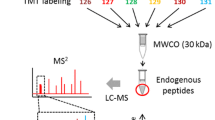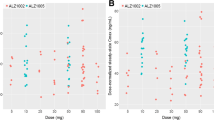Abstract
Background
The concentration of amyloid β (Aβ) peptides in cerebrospinal fluid (CSF) is a biomarker for Alzheimer’s disease (AD) pathology, and has been used to evaluate the effectiveness of γ-secretase inhibition. Avagacestat is a selective γ-secretase inhibitor in development for the treatment of AD. The primary objective of this study was to assess the effects of single oral doses of avagacestat on the CSF Aβ concentrations in healthy male subjects. Secondary objectives included single-dose pharmacokinetics in CSF and plasma, safety and tolerability.
Methods
This was a double-blind, placebo-controlled, randomized, single-dose study. Healthy male subjects were assigned to one of three sequential avagacestat dose panels (50, 200 and 400 mg) or placebo as single oral doses.
Results
34 subjects were enrolled. Administration of a single dose of 200 or 400 mg of avagacestat resulted in a marked decrease in CSF Aβ1–38, Aβ1–40 and Aβ1–42 concentrations vs placebo; with smaller decreases observed in the 50 mg dose group. Avagacestat was quickly absorbed into the systemic circulation, with a mean time to reach maximum plasma concentration (tmax) of approximately 1–2 h, and a CSF tmax of approximately 3 h. Adverse events were uncommon and occurred with similar frequency in the placebo and avagacestat groups.
Conclusion
Avagacestat was safe, well tolerated, and resulted in a notable decrease in CSF Aβ concentrations, suggestive of γ-secretase inhibition. The results warrant further clinical study in patients with AD.




Similar content being viewed by others
References
Kinkingnehun S, Sarazin M, Lehericy S, et al. VBM anticipates the rate of progression of Alzheimer disease: a 3-year longitudinal study. Neurology. 2008;70(23):2201–11.
Morris JC, Price AL. Pathologic correlates of nondemented aging, mild cognitive impairment, and early-stage Alzheimer’s disease. J Mol Neurosci. 2001;17(2):101–18.
Selkoe DJ, Wolfe MS. Presenilin: running with scissors in the membrane. Cell. 2007;131(2):215–21.
Henley DB, May PC, Dean RA, et al. Development of semagacestat (LY450139), a functional gamma-secretase inhibitor, for the treatment of Alzheimer’s disease. Expert Opin Pharmacother. 2009;10(10):1657–64.
Ghosh AK, Brindisi M, Tang J. Developing beta-secretase inhibitors for treatment of Alzheimer’s disease. J Neurochem. 2012;120(Suppl 1):71–83.
Broersen K, Rousseau F, Schymkowitz J. The culprit behind amyloid beta peptide related neurotoxicity in Alzheimer’s disease: oligomer size or conformation? Alzheimers Res Ther. 2010;2(4):12.
Hardy J. The amyloid hypothesis for Alzheimer’s disease: a critical reappraisal. J Neurochem. 2009;110(4):1129–34.
George-Hyslop P, Haines J, Rogaev E, et al. Genetic evidence for a novel familial Alzheimer’s disease locus on chromosome 14. Nat Genet. 1992;2(4):330–4.
Mullan M, Houlden H, Windelspecht M, et al. A locus for familial early-onset Alzheimer’s disease on the long arm of chromosome 14, proximal to the alpha 1-antichymotrypsin gene. Nat Genet. 1992;2(4):340–2.
Schellenberg GD, Bird TD, Wijsman EM, et al. Genetic linkage evidence for a familial Alzheimer’s disease locus on chromosome 14. Science. 1992;258(5082):668–71.
Van Broeckhoven C, Backhovens H, Cruts M, et al. Mapping of a gene predisposing to early-onset Alzheimer’s disease to chromosome 14q24.3. Nat Genet. 1992;2(4):335–9.
Comery TA, Martone RL, Aschmies S, et al. Acute gamma-secretase inhibition improves contextual fear conditioning in the Tg2576 mouse model of Alzheimer’s disease. J Neurosci. 2005;25(39):8898–902.
Martone RL, Zhou H, Atchison K, et al. Begacestat (GSI-953): a novel, selective thiophene sulfonamide inhibitor of amyloid precursor protein gamma-secretase for the treatment of Alzheimer’s disease. J Pharmacol Exp Ther. 2009;331(2):598–608.
Panza F, Solfrizzi V, Frisardi V, et al. Beyond the neurotransmitter-focused approach in treating Alzheimer’s disease: drugs targeting beta-amyloid and tau protein. Aging Clin Exp Res. 2009;21(6):386–406.
Neugroschl J, Sano M. An update on treatment and prevention strategies for Alzheimer’s disease. Curr Neurol Neurosci Rep. 2009;9(5):368–76.
Artavanis-Tsakonas S, Rand MD, Lake RJ. Notch signaling: cell fate control and signal integration in development. Science. 1999;284(5415):770–6.
Kadesch T. Notch signaling: a dance of proteins changing partners. Exp Cell Res. 2000;260(1):1–8.
Gillman KW, Starett JJE, Parker MF. Discovery and evaluation of BMS-708163, a potent, selective, and orally bioavailable gamma secretase inhibitor. ACS Med Chem Lett 2010;1(3):120–124.
Meredith J, Albright CF, Dockens R, et al. BMS-708163, a notch-sparing GSI, decreases central Aβ in rats, dogs, and humans with a therapeutic margin relative to notch toxicity. Neurodegenerative Dis 2011;8(S1):1.
Tong G, Castaneda L, Wang J-S, et al. A study to evaluate the effects of single oral doses of BMS-708163 in the cerebrospinal fluid of healthy young men. Alzheimer’s Dementia. 2010;6(4):S143.
Wang J-S, Castaneda L, Sverdlov A, et al. A placebo-controlled, ascending, multiple-dose study to evaluate the safety, pharmacokinetics, and pharmacodynamics of BMS-708163 in healthy young and elderly subjects. Alzheimer’s Dementia. 2010;6(4):S540.
Dockens R, Karkas J, Zheng M, et al. Effect of concomitant administration of multiple doses of BMS-708163 on safety, tolerability, and the pharmacokinetics of midazolam, warfarin, caffeine, omeprazole, and dextromethorphan in healthy male subjects by administration of a modified Cooperstown cocktail. Alzheimer’s Dementia. 2010;6(4):S536.
Mattsson N, Zetterberg H, Hansson O, et al. CSF biomarkers and incipient Alzheimer disease in patients with mild cognitive impairment. JAMA. 2009;302(4):385–93.
Bateman RJ, Siemers ER, Mawuenyega KG, et al. A gamma-secretase inhibitor decreases amyloid-beta production in the central nervous system. Ann Neurol. 2009;66(1):48–54.
Siemers E, Skinner M, Dean RA, et al. Safety, tolerability, and changes in amyloid beta concentrations after administration of a gamma-secretase inhibitor in volunteers. Clin Neuropharmacol. 2005;28(3):126–32.
Siemers ER. How can we recognize “disease modification” effects? J Nutr Health Aging. 2009;13(4):341–3.
Gu H, Deng Y, Wang J, et al. Development and validation of sensitive and selective LC-MS/MS methods for the determination of BMS-708163, a gamma-secretase inhibitor, in plasma and cerebrospinal fluid using deprotonated or formate adduct ions as precursor ions. J Chromatogr B Analyt Technol Biomed Life Sci. 2010;878(25):2319–26.
Perrier D, Gibaldi M. General derivation of the equation for time to reach a certain fraction of steady state. J Pharm Sci. 1982;71(4):474–5.
Riegelman S, Collier P. The application of statistical moment theory to the evaluation of in vivo dissolution time and absorption time. J Pharmacokinet Biopharm. 1980;8(5):509–34.
Waring J, Slats D, Gonzalez C, et al. An assessment of variability in CSF biomarkers in clinical experimental models: a meta-analysis. Alzheimer’s Dementia. 2012;7(4):S101.
Burton CR, Meredith JE, Barten DM, et al. The amyloid-beta rise and gamma-secretase inhibitor potency depend on the level of substrate expression. J Biol Chem. 2008;283(34):22992–3003.
Lanz TA, Karmilowicz MJ, Wood KM, et al. Concentration-dependent modulation of amyloid-beta in vivo and in vitro using the gamma-secretase inhibitor, LY-450139. J Pharmacol Exp Ther. 2006;319(2):924–33.
Siemers ER, Dean RA, Friedrich S, et al. Safety, tolerability, and effects on plasma and cerebrospinal fluid amyloid-beta after inhibition of gamma-secretase. Clin Neuropharmacol. 2007;30(6):317–25.
Fleisher AS, Raman R, Siemers ER, et al. Phase 2 safety trial targeting amyloid beta production with a gamma-secretase inhibitor in Alzheimer disease. Arch Neurol. 2008;65(8):1031–8.
Acknowledgments
This study was supported by Bristol-Myers Squibb. The authors would like to acknowledge the writing and editorial support of Brian Atkinson, PhD, Bristol-Myers Squibb.
Conflicts of interest
All authors are employees of Bristol-Myers Squibb.
Author information
Authors and Affiliations
Corresponding author
Rights and permissions
About this article
Cite this article
Tong, G., Castaneda, L., Wang, JS. et al. Effects of Single Doses of Avagacestat (BMS-708163) on Cerebrospinal Fluid Aβ Levels in Healthy Young Men. Clin Drug Investig 32, 761–769 (2012). https://doi.org/10.1007/s40261-012-0006-4
Published:
Issue Date:
DOI: https://doi.org/10.1007/s40261-012-0006-4




